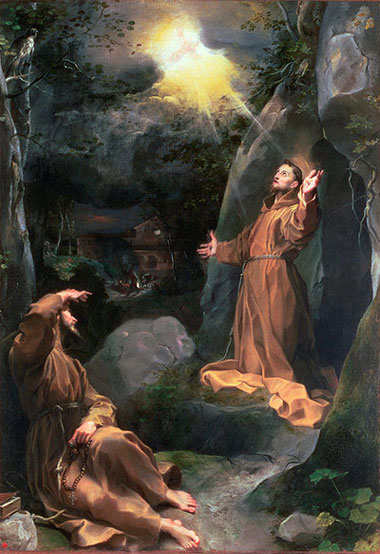The National Gallery’s Barocci paintings show the glory of the counter-Reformation
The richness of their theology is lost on the curators, though
By Fr Alexander Lucie-Smith on Friday, 5 April 2013

The Stigmatisation of St Francis (1594-95)
There are several reasons why one should go to the Barocci exhibition currently on at the National Gallery.
First of all, it is the opportunity of a lifetime to get to grips with this artist. Only two of his works have permanent homes in Britain: this exhibition gathers works from all four corners of the globe, so seeing such a considerable body of the artist’s work all in one place is not something that is likely to recur any time soon. The curators have assembled several canvases and the preparatory drawings too, so that enables us to see how the artist worked. In addition, the collection makes clear the way the artist progressed: I have to say, and many may disagree with me, his earlier work is by far his best. The link given above allows you to look at some of the exhibits online.
The second reason to go is because Federico Barocci is an artist of whom – be honest – you have never heard, and a good artist too. Every now and then there is an attempt to claim that some half forgotten painter is a neglected genius, but in this case it is probably true.
Barocci spent most of his working life in Urbino, which, if the National Gallery’s film is anything to go by, is a beautiful place. His patron, Duke Francesco Maria II della Rovere, was very religious, and so was the artist. With the exception of some portraits, and one canvas depicting Aeneas fleeing Troy, all of Barocci’s paintings are religious, either altarpieces, or else made for private devotion. Several are still in the churches for which they were painted, such as a Visitation made for the Chiesa Nuova in Rome, which was the object of rapt contemplation by St Philip Neri himself. The labelling of the exhibits betrays the fact that the curators have little working knowledge of Catholicism, and they make no attempt to analyse Barocci as a religious, even theological, painter. But he certainly was that, and it is clear that he was deeply devoted to the Madonna and to St Francis, and much taken with the incarnation aspects of the Catholic faith.
Barocci did venture to Rome, where, it is thought, jealous rivals attempted to poison him. He attributed his survival and eventual cure to the intercession of the Madonna. It is rather a good thing that he survived; his paintings are one of the glories of counter-Reformation Catholicism, and I particularly liked his Rest on the Return from Egypt, which is partially reproduced here. This is an unusual subject. One can see it is the return from Egypt, not the outward journey, because the Child is quite big. Theologically, this is a rich seam for contemplation. The word “rest” is biblically rich too. One wonders, though, just how much of these layers of meaning a modern audience will absorb. Can a secular world really appreciate such brilliance and grace, to use the National Gallery’s phrase?
No comments:
Post a Comment